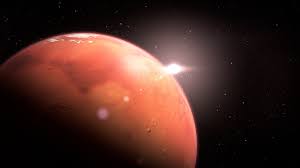When it comes to our neighboring planet, Mars, one of the questions that is asked the most frequently is, “Is Mars hot or cold?” When it comes to our efforts to investigate and possibly settle the Red Planet, having a solid grasp of the climate there is absolutely necessary. Mars’ climate is very different from that of Earth, despite the fact that the two planets share significant commonalities. Let’s delve into the interesting world of Martian weather and figure out what the deal is with the planet’s wildly fluctuating temperatures, shall we?
Mars is commonly referred to as the “Red Planet” due to the fact that its surface is covered in iron oxide, which gives it a rusty look. It is the fourth planet from the Sun and its distance from the sun is around 142 million miles on average. Even while Mars has seasons like Earth does, its climate is much more harsh and not suitable for human life.
Before we can begin our exploration, we need to have a solid understanding of the components that contribute to the climate on Mars. Mars’ extreme distance from the sun, its relatively sparse atmosphere, and the absence of a major greenhouse effect are the primary factors in this phenomenon. Mars is approximately one-half the size of Earth, and its gravity is only about 38% as strong as that of our planet. These elements each contribute in their own unique way to the formation of their climate.
Mars has an average temperature that is many degrees lower than that of Earth. The temperature on the surface of Mars is extremely cold, with certain locations experiencing temperatures that are even lower than the average of -80 degrees Fahrenheit (-62 degrees Celsius). Temperatures can reach a relatively mild -20 degrees Fahrenheit (-29 degrees Celsius) near the equator during the day, which is the time of day when they are at their warmest.
The sparse atmosphere of Mars, which has just around 1% of the density of Earth’s atmosphere, is a major factor in the planet’s freezing temperatures. Mars has a hard time keeping its heat due to its extremely thin atmosphere. Mars’ atmosphere is not very good at storing the sun’s energy, in contrast to the atmosphere of Earth, which acts as a heat sink and also helps to transfer heat. As a direct consequence of this, temperatures fall dramatically during the course of the night, with some places witnessing temperature changes of more than 73 degrees Celsius (nearly 100 degrees Fahrenheit).
Mars, although being an essentially frigid planet, does undergo rare increases in temperature, which is an interesting phenomenon to consider. These shifts in temperature are the result of a number of different phenomena, such as dust storms, shifts in air pressure, and seasonal oscillations. Huge dust storms have the potential to encompass the entire planet, which would trap heat and lead to temperature spikes in specific areas.
It is important to point out that Mars is an exceedingly unfavorable environment for human habitation due to its exceptionally low temperatures and its incredibly thin atmosphere. On the surface of Mars, human beings could not possibly maintain their lives without access to climate-controlled homes and appropriate protective gear. However, there is ongoing study being conducted, as well as progress being made in the field of space travel, with the goal of overcoming these obstacles and paving the road for future human journeys to Mars.
Researchers have dispatched a variety of spacecraft, rovers, and orbiters to the surface of Mars to investigate the planet’s atmospheric conditions and temperature patterns in order to achieve a more all-encompassing comprehension of the planet’s environment. Our understanding of Mars and its climate has been vastly improved as a direct result of the data that was gathered throughout these missions, which has provided us with information that will be extremely helpful for any future exploration endeavors.
To summarize, Mars is, without a shadow of a doubt, a frigid planet. Its atmosphere is quite thin, and there isn’t enough of a greenhouse effect for it to have a significant impact, hence the planet’s average temperature is significantly lower than that of Earth. Even if there are localized heat waves on Mars from time to time due to dust storms and other circumstances, the planet’s climate as a whole is still incompatible with human life. Our understanding of the climate of the Red Planet will continue to develop as we conduct further exploration and research on the planet. This will bring us one step closer to deciphering the mysteries that surround our neighbor in the cosmos.
![]()
